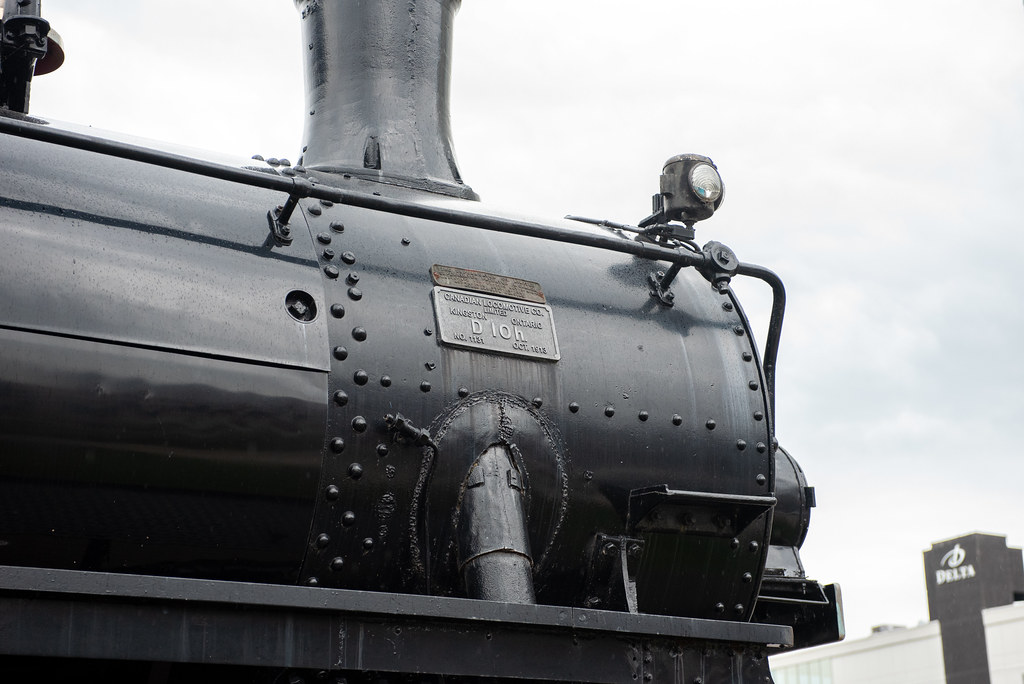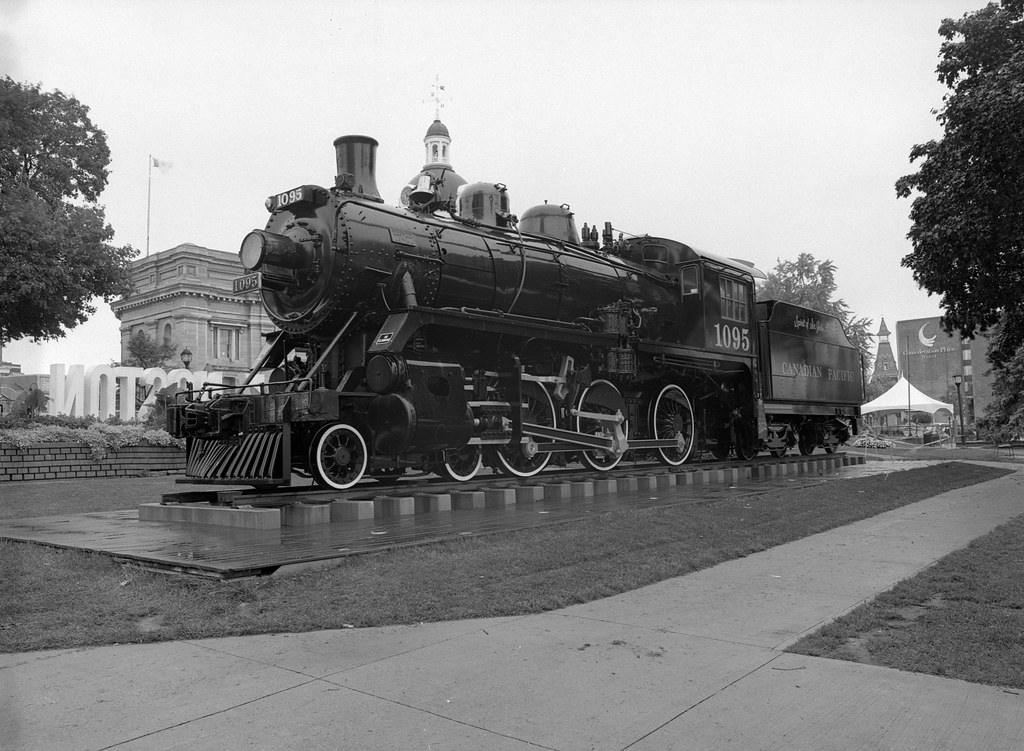When it comes to locomotives and locomotive production in Canada, the history is long and varied. But for the city of Kingston, the manufacture of locomotives started at the start of the railroad age for Ontario, and the former Canadian Pacific locomotive 1095 is a reminder of the city’s industrial heritage. I will note that the locomotive has been named “Spirit of Sir John A” after Canada’s first Prime Minister, Sir John A. MacDonald, about his push to have the Canadian Pacific Railway and its transcontinental line completed in 1886. However, Sir John A MacDonald and his Government, along with future Canadian Governments, also pushed for the assimilation of Canada’s Indigenous Peoples through the expansion of the Indian Residential School System, a cultural genocide. Note, that this system had been originally established by the former British Colonial government back in the 1830s and slowly expanded over time. Therefore by recognising the harm done by these systems, I will not be referring to the locomotive by that name, only its number 1095.

Crown Graphic – Fuji Fujinon-W 1:5.6/125 – Ilford HP5+ @ ASA-200 – Pyrocat-HD (1+1+100) 9:00 @ 20C
Canadian Locomotive Company traces itself to 1848 and the Ontario Foundry’s founding west of Kingston downtown on the heavily industrialised waterfront. The foundry produced the usual metal home appliances of the day and dabbled in stationary steam engines. From there, it would only be a small leap into steam locomotives, changing their name to Kingston Locomotive works in 1850. Between 1854 and 1860, under three dozen iron horses were produced by Grand Trunk Railway before going bankrupt and shutting down. Under new investment and management, the factory reopened as the Canadian Engine & Machinery in 1865, but the economic downturn in 1873 forced the closure in 1878. By 1879, investors in Canadian Pacific Railway needed to secure a locomotive source for their new line. With the new investment, the Canadian Locomotive & Engine Co and allowing expansion in 1881. It also provided an easy source for raising capital for Canadian Pacific; when money was needed, shares in Canadian Locomotive & Engine were sold off to Dubs & Co, who operated the Glasgow Locomotive Works. By 1888 Dubs & Co gained complete control and a solid reputation for their locomotives. By the 1900s, Canadian Pacific and Grand Trunk began manufacturing their locomotives, and Canadian Locomotive & Engine went bankrupt. Although local interests had no desire to see a significant employer go under, it reinvested and reopened in 1901 as the Canadian Locomotive Company and quickly ramped up production to produce one locomotive per week.

Nikon D750 – AF-S Nikkor 28-70mm 1:2.8D
Nikon D750 – AF-S Nikkor 28-70mm 1:2.8D
One such contract starting in 1907 came from Canadian Pacific to produce the D10 class of locomotive. The D10 class, or a 4-6-0 “Ten-Wheeler”, by 1907, was already an old style of steam locomotive. First developed in 1847 by Septimus Norris from the Norris Locomotive Works, the 4-6-0 is an improvement on the 4-4-0 “American” and first appeared in the fleet of the Philidelphia & Reading Railroad. The four leading and six driving wheels provided excellent speed and stability, while the lack of trailing wheels gave the Ten-Wheeler high-adhesive weight. While the locomotive had a large boiler and could use as a freight driver, yard-switcher or mixed-use, the small firebox made it less ideal for long-distance passenger services. Passenger trains were better suited for the successor engines, the 4-6-2 “Pacific” or 2-8-0 “Mikado”. Canadian Pacific used their D10s for freight, yard-switching and slower branch passenger services, producing them at their own Angus Shops along with Montreal Locomotive Works and Canadian Locomotive Company. In October 1913, Locomotive No. 1131 rolled out from the Canadian Locomotive Works, travelled along the branch and entered into Canadian Pacific Service at the former Kingston & Pembroke Yard with the number 1095 attached. Locomotive 1095 stood as part of the final batch of D10 locomotives. Designated a D10h, 1095 carried a 180 PSI boiler featuring 62″ driver wheels and 19×24″ cylinders.

Nikon D750 – AF-S Nikkor 28-70mm 1:2.8D
Nikon D750 – AF-S Nikkor 28-70mm 1:2.8D
From Kingston, 1095 travelled out to Winnipeg, where it spent the balance of its service life—returning to Southern Ontario in the Post-War period. There is little known about the service life of 1095, but it probably spent time on lonely branch lines running freight or mixed-use trains out in Manitoba and then later Southern Ontario. The locomotive was among the final D10s to be retired in 1960. After a brief stint at Montreal and a restoration at the Angus Shops, it returned to Kingston in 1867. The final train arrived at the old railyard, which was already under transformation into Confederation Park. Here the old locomotive began an instant tourist attraction with tonnes of people wanting their photos in front. While 1095 fared well, the Canadian Locomotive Company did not. Since the post-war, the company struggled to keep up after joining Baldwin Locomotive Works and a series of less-than-successful diesel-electric locomotives. Despite a brief turnaround with better designs from Fairbanks-Morris, by 1969, a strike crippled the plant. And having no financial foundation to stand on, the company closed for good the same year. The years dragged on for 1095, and like any locomotive displayed outside, the weather, tourists, and time took their toll. By 2006 the engine, now protected by a fence, did not look well, and a group of volunteers rallied around the old horse. In 2007 funds were raised to have an assessment conducted and presented to the city. Surprisingly the city accepted the report and assigned a budget line for funding towards restoration. Fundraising also occurred throughout the city, along with the support needed to do the actual work. The work started in 2011, with several businesses around Ontario lending their help; the biggest supporter is Local 221 of the Pipefitters Union. By 2012 the engine began to return to Confederation Park, with reassembling and painting completed. On 1 July 2013, Locomotive 1095 was rededicated a few months short of its 100th birthday. Today it still enjoys a place in the memory cards of tourists who, even on the dull wet day I visited, happily posed in front of the beautifully restored locomotive.

Mamiya m645 – Mamiya-Sekor C – Ilford HP5+ @ ASA-200 – Pyrocat-HD (1+1+100) 9:00 @ 20C
Correction, Sir Joihn A. did not start the Indian residential school system, “the harm MacDonald started”. It began many years before Sir John was Prime Minister and continued while Pierre Eliott Trudeau was PM.
Note, Sir John gave the Indigenous the vote but was later rescinded fy Sir Wilfred Laurier.
Thank you for your comment, I have updated the entry to reflect a better understanding.